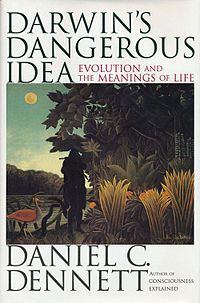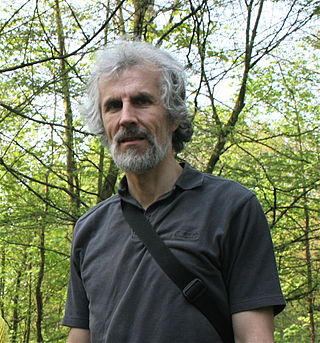Related Research Articles

Darwin's Dangerous Idea: Evolution and the Meanings of Life is a 1995 book by the philosopher Daniel Dennett, in which the author looks at some of the repercussions of Darwinian theory. The crux of the argument is that, whether or not Darwin's theories are overturned, there is no going back from the dangerous idea that design might not need a designer. Dennett makes this case on the basis that natural selection is a blind process, which is nevertheless sufficiently powerful to explain the evolution of life. Darwin's discovery was that the generation of life worked algorithmically, that processes behind it work in such a way that given these processes the results that they tend toward must be so.
A meme is an idea, behavior, or style that spreads by means of imitation from person to person within a culture and often carries symbolic meaning representing a particular phenomenon or theme. A meme acts as a unit for carrying cultural ideas, symbols, or practices, that can be transmitted from one mind to another through writing, speech, gestures, rituals, or other imitable phenomena with a mimicked theme. Supporters of the concept regard memes as cultural analogues to genes in that they self-replicate, mutate, and respond to selective pressures. In popular language, a meme may refer to an Internet meme, typically an image, that is remixed, copied, and circulated in a shared cultural experience online.
Memetics is a theory of the evolution of culture based on Darwinian principles with the meme as the unit of culture. The term "meme" was coined by biologist Richard Dawkins in his 1976 book The Selfish Gene, to illustrate the principle that he later called "Universal Darwinism". All evolutionary processes depend on information being copied, varied, and selected, a process also known as variation with selective retention. The conveyor of the information being copied is known as the replicator, with the gene functioning as the replicator in biological evolution. Dawkins proposed that the same process drives cultural evolution, and he called this second replicator the "meme," citing examples such as musical tunes, catchphrases, fashions, and technologies. Like genes, memes are selfish replicators and have causal efficacy; in other words, their properties influence their chances of being copied and passed on. Some succeed because they are valuable or useful to their human hosts while others are more like viruses.
Liane Gabora is a professor of psychology at the University of British Columbia - Okanagan. She is known for her theory of the "Origin of the modern mind through conceptual closure," which built on her earlier work on "Autocatalytic closure in a cognitive system: A tentative scenario for the origin of culture."

Susan Jane Blackmore is a British writer, lecturer, sceptic, broadcaster, and a visiting professor at the University of Plymouth. Her fields of research include memetics, parapsychology, consciousness, and she is best known for her book The Meme Machine. She has written or contributed to over 40 books and 60 scholarly articles and is a contributor to The Guardian newspaper.

Karl Marx's theory of alienation describes the separation and estrangement of people from their work, their wider world, their human nature, and their selves. Alienation is a consequence of the division of labour in a capitalist society, wherein a human being's life is lived as a mechanistic part of a social class.
Spiritual evolution, also called higher evolution, is the idea that the mind or spirit, in analogy to biological evolution, collectively evolves from a simple form dominated by nature, to a higher form dominated by the spiritual or divine. It is differentiated from the "lower" or biological evolution.
The ideosphere—like the noosphere —is the metaphysical 'place' where thoughts, theories, ideas, and ideation are regarded to be created, evaluated, and evolved.
Memetic engineering, also meme engineering, is a term developed by Leveious Rolando, John Sokol, and Gibron Burchett based on Richard Dawkins' theory of memes.

Francis Paul Heylighen is a Belgian cyberneticist investigating the emergence and evolution of intelligent organization. He presently works as a research professor at the Vrije Universiteit Brussel, where he directs the transdisciplinary "Center Leo Apostel" and the research group on "Evolution, Complexity and Cognition". He is best known for his work on the Principia Cybernetica Project, his model of the Internet as a global brain, and his contributions to the theories of memetics and self-organization. He is also known, albeit to a lesser extent, for his work on gifted people and their problems.

Ervin László is an American philosopher of science, systems theorist, integral theorist, originally a classical pianist. He is an advocate of the theory of quantum consciousness.

Barbara Marx Hubbard, American futurist, author, and public speaker. She is credited with The Wheel of Co-Creation 2.0 and concepts of "The Synergy Engine" and the "birthing" of humanity.
Aaron Lynch was an American writer, best known for his book Thought Contagion: How Belief Spreads Through Society.
A memetic algorithm (MA) in computer science and operations research, is an extension of the traditional genetic algorithm (GA) or more general evolutionary algorithm (EA). It may provide a sufficiently good solution to an optimization problem. It uses a suitable heuristic or local search technique to improve the quality of solutions generated by the EA and to reduce the likelihood of premature convergence.
Cultural selection theory is the study of cultural change modelled on theories of evolutionary biology. Cultural selection theory has so far never been a separate discipline. However it has been proposed that human culture exhibits key Darwinian evolutionary properties, and "the structure of a science of cultural evolution should share fundamental features with the structure of the science of biological evolution". In addition to Darwin's work the term historically covers a diverse range of theories from both the sciences and the humanities including those of Lamark, politics and economics e.g. Bagehot, anthropology e.g. Edward B. Tylor, literature e.g. Ferdinand Brunetière, evolutionary ethics e.g. Leslie Stephen, sociology e.g. Albert Keller, anthropology e.g. Bronislaw Malinowski, Biosciences e.g. Alex Mesoudi, geography e.g. Richard Ormrod, sociobiology and biodiversity e.g. E.O. Wilson, computer programming e.g. Richard Brodie, and other fields e.g. Neoevolutionism, and Evolutionary archaeology.
The study of memes, units of cultural information, often involves the examination of meme complexes or memeplexes. Memeplexes, comparable to the gene complexes in biology, consist of a group of memes that are typically present in the same individual. This presence is due to the implementation of Universal Darwinism's theory, which postulates that memes can more effectively reproduce themselves when they collaborate or "team up".

Blindsight is a hard science fiction novel by Canadian writer Peter Watts, published by Tor Books in 2006. It won the Seiun Award for best translated novel and was nominated for the Hugo Award for Best Novel, the John W. Campbell Memorial Award for Best Science Fiction Novel, and the Locus Award for Best Science Fiction Novel. The story follows a crew of astronauts sent to investigate a trans-Neptunian comet dubbed "Burns-Caulfield" that has been found to be transmitting an unidentified radio signal, followed by their subsequent first contact. The novel explores themes of identity, consciousness, free will, artificial intelligence, neurology, and game theory as well as evolution and biology.
The concept of the evolution of morality refers to the emergence of human moral behavior over the course of human evolution. Morality can be defined as a system of ideas about right and wrong conduct. In everyday life, morality is typically associated with human behavior rather than animal behavior. The emerging fields of evolutionary biology, and in particular evolutionary psychology, have argued that, despite the complexity of human social behaviors, the precursors of human morality can be traced to the behaviors of many other social animals. Sociobiological explanations of human behavior remain controversial. Social scientists have traditionally viewed morality as a construct, and thus as culturally relative, although others such as Sam Harris argue that there is an objective science of morality.
Universal Darwinism, also known as generalized Darwinism, universal selection theory, or Darwinian metaphysics, is a variety of approaches that extend the theory of Darwinism beyond its original domain of biological evolution on Earth. Universal Darwinism aims to formulate a generalized version of the mechanisms of variation, selection and heredity proposed by Charles Darwin, so that they can apply to explain evolution in a wide variety of other domains, including psychology, linguistics, economics, culture, medicine, computer science, and physics.
Spiral Dynamics (SD) is a model of the evolutionary development of individuals, organizations, and societies. It was initially developed by Don Edward Beck and Christopher Cowan based on the emergent cyclical theory of Clare W. Graves, combined with memetics. A later collaboration between Beck and Ken Wilber produced Spiral Dynamics Integral (SDi). Several variations of Spiral Dynamics continue to exist, both independently and incorporated into or drawing on Wilber's Integral theory. Spiral Dynamics has applications in management theory and business ethics, and as an example of applied memetics. However, it lacks mainstream academic support.
References
- 1 2 Barbara Marx Hubbard (2015-11-28). "Eco-Futurist Creates Revolutionary 10 Point Plan To Save Humanity & The Planet" . Retrieved 2018-09-22.
- ↑ Yusupova, Julie A. (2023). "On the Topology of the Noosphere". Journal of Conscious Evolution. 20. Retrieved 28 December 2023.
- ↑ Birkin, Frank; Edwards, Pam; Woodward, David (2005-04-01). "Accounting's contribution to a conscious cultural evolution: an end to sustainable development". Critical Perspectives on Accounting. 16 (3): 185–208. doi:10.1016/S1045-2354(03)00023-6. ISSN 1045-2354.
- 1 2 3 Dennett, Daniel (1995). Darwin's Dangerous Idea . Simon & Schuster. ISBN 978-0-684-82471-0.
- ↑ Dawkins, Richard (1978). The selfish gene. New York: Oxford University Press.
- 1 2 3 4 Banathy, Bela H. (2003-01-16). "Self-guided/conscious evolution". Systems Research and Behavioral Science. 20 (4): 309–321. doi: 10.1002/sres.506 . ISSN 1092-7026.
- 1 2 Taborga, Jorge. "8/15 – Integral Conscious Evolution - Integral Leadership Review". integralleadershipreview.com. Retrieved 2018-09-22.
- ↑ Cobbold, Robert (2020-09-12). "Conscious Evolution" . Retrieved 2020-09-12.
- 1 2 Csikszentmihalyi, M. (1993). The Evolving Self: A Psychology for the New Millennium. New York: Harper Perennial.
- 1 2 3 Salk, J. (1983). Anatomy of Reality: Merging Intuition and Reason. New York: Columbia University Press.
- ↑ Atlee, Tom (2008). "Co-intelligence, Collective Intelligence, and Conscious Evolution". Collective Intelligence: Creating a Prosperous World at Peace. Earth Intelligence Network: 5–14.
- 1 2 3 Chaisson, E. (1987). The Life Era. New York: The Atlantic Monthly Press.
- 1 2 Hubbard, B. (1996). Conscious Evolution. Novato, CA: New World Library.
- 1 2 London, Scott. "Conscious Evolution :: A Book Review by Scott London". www.scottlondon.com. Retrieved 2018-09-22.